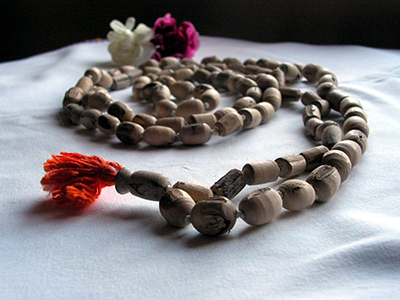Buddhist Mala
Mala

By GourangaUK. (Own work; transferred from en.wikipedia.) [CC-BY-SA-2.5], via Wikimedia Commons
Buddhists use prayer beads called Japa Mala or mala, much as Hindus do. In Sanskrit, mala means "garland", while Japa means to recite or chant a mantra or name of a deity. In Japanese Buddhism, they are called nenju (Japanese for 'beads used for mindful practice') or juzu (counting beads). The mala are used to count the recitations.
There is great variety in the types of malas used by Buddhists. Malas usually have 108 beads or a divisor of 108, such as 16, 27 or 54. Most have one or two additional, larger beads, called Guru beads.
Materials used
Malas are made from a variety of materials; Buddhist mala beads may be made from:
- Wood from the Bodhi tree.
- 'Bodhi seeds' which are really the seeds of the rudraksha tree.
- Wood of the Tulsi plant.
- Rattan seeds.
- Sandalwood.
- Bone.
- Precious or semi-precious stones.
- Crystal, pearl, shell or mother of pearl.
Usage
Malas are most often used to count repetitions of a mantra, prayers, or the name of a deity. A mantra is a sound, syllable, word or group of these, whose repetition is believed to aid in attaining Enlightenment.
One repetition is said for each bead, turning each bead clockwise with the fingers, though some traditions use a counterclockwise motion. Hundreds or even thousands of repetitions are often said, though fewer are also common. When the Guru bead is reached the direction is changed, if more repetitions are being done than there are beads.